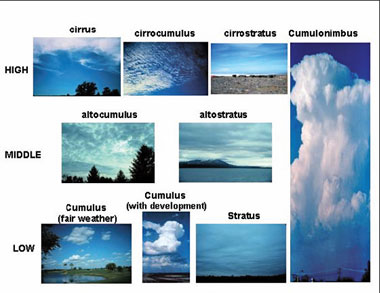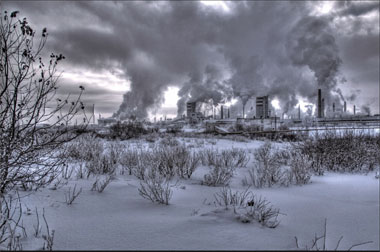|

Who gave clouds their common names

Before 1800 everyone spoke of clouds only as ' essences' floating in
the sky. Clouds were not identified by their shapes as they are done
today. It was a British inventor named Luke Howard ( 1773-18640) who
noted that there are three basic shapes to clouds: heaps of separated
cloud masses with flat bottoms and cauliflower tops, which he named
cumulus (Latin for heap), layers of cloud much wider than they are
thick, like a blanket or a mattress, which he named stratus (Latin for
layer) and ; wispy curls, like a child's hair, which he called cirrus
(Latin for curl). To clouds generating precipitation, he gave the name
nimbus (Latin for rain).Clouds are found in three layers in the lower
atmosphere.
With four types of clouds and three layers, we come up with 12 major
cloud types that have evolved from Luke Howard's pioneering work.
 What
discovery was made by putting trumpeters on a train What
discovery was made by putting trumpeters on a train
The discovery was the Doppler effect. It explains why a moving sound
such as the siren of an ambulance drops in pitch when it passes you.
Even though the effect had been long known, it was only in 1842 that
the Austrian Scientist Christian Doppler explained why it happens. He
proved that this happens because the sound waves reach the ear less
quickly as the source moves away and, as the frequency decreases, so the
pitch drops.
To test it he placed a group of trumpeters on a train and had it
driven to and fro past several musicians who wrote down the note that
they heard as the trumpeters passed. The results showed his theory was
right and so the effect was named after him.
 What
would happen in a nuclear winter What
would happen in a nuclear winter
A nuclear winter is what could result if ever there was a war using
nuclear weapons. Many scientists believe this could happen because of
the power of the nuclear weapons. The immense destruction could result
in a vast amount of smoke to rise into the atmosphere. The wind will
blow this material around the world and it will block the sunlight.
Scientists say if this happens there will be a savage winter
extending possibly over the whole world. It would cause crops to die and
there will be little hope of survival for anyone who manages to escape
the destructive forces of the nuclear war.
 How
holograms are made How
holograms are made
A hologram of an object is made on a piece of photographic film by
using a laser. The object is lit by the laser and this flight is
reflected by the object to the film. Light from the laser also strikes
the film directly. The light from the object and from the laser combine
to produce a pattern, which shows when the film is developed. The
pattern does not resemble the object - until the film is illuminated.
Then the object appears and this is called a hologram. The image is
three dimensional having depth like the real object. By moving your head
you can see round any corners in the image.
Each part of the film actually contains a slightly different image of
the object. When you look at a hologram, each eye therefore, receives a
separate image and these images combine to give the realistic three
dimensional effect.
 Who
invented the earliest seismoscope Who
invented the earliest seismoscope
The Chinese philosopher,astronomer and mathematician Chang Heng
invented the earliest known seismoscope in 132 A.D. He called it an
"earthquake weathercock.' The instrument was said to resemble a wine jar
of diametre six feet. On the outside of the vessel there were eight
dragon heads, facing the eight principal directions ofthe compass. Below
each of the dragon heads was a toad, with its mouth opened towards the
dragon. The mouth of each dragon held a ball. At the occurrence of an
earthquake, one of the eight dragon-mouths would release a ball into the
open mouth of the toad situated below. The direction of the shaking
determined which of the dragons released its ball.
The instrument is reported to have detected a four-hundred-mile
distant earthquake which was not felt at the location of the
seismoscope.The insideof the Chinese seismoscope is unknown. In 136 A.D.
a Chinese scientist named Choke updated this meter and called it a "seismoscope."
Seismologists of the nineteenth and twentieth centuries have speculated
on mechanisms which would duplicate the behaviour of Chang Heng's
seismoscope, but would not be beyond the Chinese technology of Chang
Heng's time.
All assume the use of some kind of pendulum as the primary sensing
element, the motion of which would activate one of the dragons.
Seismologists study earthquakes by going out and looking at the
damage caused by the earthquakes and by using seismographs. A
seismograph is an instrument that records the shaking of the earth's
surface caused by seismic waves.
The term seismometer is also used to refer to the same device. |


